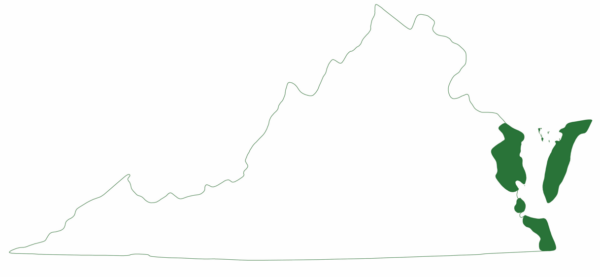Fact File
Scientific Name: Caretta caretta
Classification: Reptilia, Order Testudines, Family Cheloniidae
Conservation Status:
- Federally Endangered in the U.S.
- State Threatened in Virginia
- Species of Greatest Conservation Need-Tier 1a on the Virginia Wildlife Action Plan
Size: Up to 42 inches in length
Identifying Characteristics
This is a large sea turtle that grows to lengths of 84 inches. The carapace is heart shaped, without striations on the surface, and brown to reddish brown in color. The plastron (lower shell) is hingeless, smaller than the carapace (upper shell), and cream to yellowish in color. Star-shaped light and dark streaks may be present on the carapace. The top of the head, the neck, and the front of the fore-flippers are reddish brown. The snout is short and the upper jaw is yellowish brown. The entire undersurface, side of the neck, and parts of the flippers are cream to yellow. The fore-flippers are large, about half the length of the carapace; the hind-flippers are short and paddle-like. Each flipper bears one or 2 claws. Hatchling and juvenile loggerheads have a brown carapace with 3 dorsal keels. The breeding season is from April to August. Incubation takes 55-70 days, and there are 2 to 3 nestings per year, with an average clutch size of 119 eggs.
Habitat
Loggerhead Sea Turtles occur as far north as Newfoundland and northern Europe and as far south as Argentina. In Virginia, they are found throughout the lower Chesapeake Bay, in the seaside marsh and barrier island system seaward of the Eastern Shore, and in adjacent ocean waters
Distribution:
The loggerhead is the most abundant sea turtle in Virginia’s coastal waters. It is found only in salt water, in the Chesapeake Bay from Baltimore south, in all the major rivers along Virginia’s coast, and into channels between barrier islands. The Chesapeake Bay is an important summer foraging area for subadults between the ages of 5 and 15 years. Nearly all nesting sites are on barrier islands in the United States. Nesting habitat is a sand beach that is high enough that it is not inundated by high tides nor soaked by ground water rising from below.

Did you know?
Juvenile loggerheads less than 12 years old typically do not occur in U.S. waters, but are believed to live a pelagic existence passively entrained in the North Atlantic gyre.
Last updated: January 19, 2024
The Virginia Department of Wildlife Resources Species Profile Database serves as a repository of information for Virginia’s fish and wildlife species. The database is managed and curated by the Wildlife Information and Environmental Services (WIES) program. Species profile data, distribution information, and photography is generated by the Virginia Department of Wildlife Resources, State and Federal agencies, Collection Permittees, and other trusted partners. This product is not suitable for legal, engineering, or surveying use. The Virginia Department of Wildlife Resources does not accept responsibility for any missing data, inaccuracies, or other errors which may exist. In accordance with the terms of service for this product, you agree to this disclaimer.

